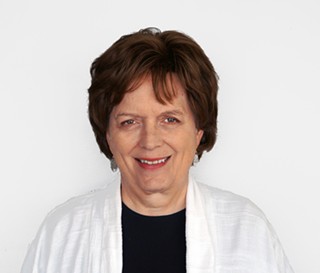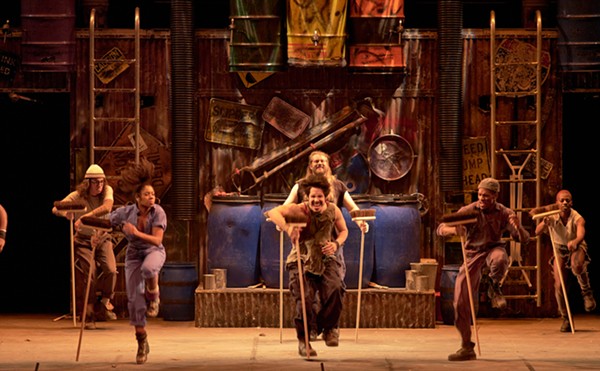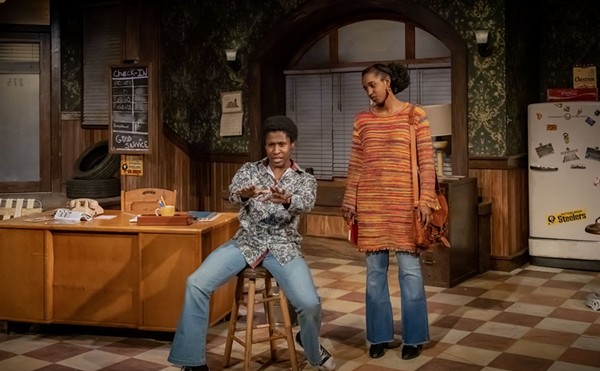If you're on your deathbed and there's a big crow in your closet trying to get out, that's probably not a good sign. Crows have been a symbol of death in many cultures, probably because they are fond of feeding on carrion.
In Woman and Scarecrow, now being produced by the Mamai Theatre Company, a dying woman is being pecked at by her husband, her aunt and a female presence only referred to as the Scarecrow. It is a densely lyrical and haunting play, replete with gorgeous language by Irish playwright Marina Carr. And thanks to the precise direction by Pandora Robertson that avoids stereotypes, the experience is almost always involving.
Most of us are fascinated by plays that circle around the moment of death, from Our Town to Angels in America. And why not? Death is the most significant thing that will happen to any of us in our lifetimes, aside from a Browns' championship, and sadly only the former is assured.
The folkloric symbolism in Woman and Scarecrow is reflected in the designations of three of the characters. In addition to the generic Scarecrow, the woman is called Woman and her husband is just Him. By denying these three main characters the individual power of names, they become representatives of all of us.
Almost functioning as another character is the occasionally pulsing and growling wardrobe where the hidden messenger of death is, as Scarecrow notes, "sucking on his oily black wings." Clearly, Scarecrow knows more about what's in the wardrobe than anyone else. And whether Scarecrow is Woman's alter ego, an illusion caused by too many pills, or Carr's version of Clarence from It's a Wonderful Life, Scarecrow is out to challenge Woman about her life and her decisions.
The extended conversation between Woman and Scarecrow is fascinating, as it loops through Woman's memories of her mother, her loss of faith in God, and the troubled path of her own family. Woman has eight children, but as Scarecrow prods her it is revealed that the kids were just a tool to help maintain an abjectly contentious marriage. Indeed, some of the most striking language is devoted to the one child that was stillborn.
The script fascinates, since it mixes poetic and surreal descriptions with spontaneous spikes of humor that knife through the rather morbid situation. When Woman grabs a mirror and looks at her gaunt face, she says, "I have achieved bone! I am graveyard chic."
In the demanding role of Woman, Derdriu Ring once again proves why she is one of the leading actors in the area. Confined to a bed for the entire play, Ring's Woman never feels contained at all as she rails against her unnamed disease, scraps rather lovingly with Scarecrow, and battles her hubby and aunt to a draw. By turns profound and then childish (she holds her breath until Scarecrow plays a popular tune Woman wants to hear), Woman is a fragmented being and Ring brings this dying person to vibrant life.
Scarecrow has apparently been with Woman from the beginning, and she has a lot invested. Bernadette Clemens slowly, subtly reveals that commitment as she questions and challenges Woman, conveying her concern without ever becoming too mawkish on one hand, or too much the ruthless interrogator on the other. In these title roles, Clemens and Ring balance each other masterfully.
As Him, James Lally is forceful in his dickitude, admitting to his dalliances and then being outraged when his wife shares her little secrets. Lally and Ring fashion a second-act encounter that is angry and vicious as well as sweet and loving. And there's a marriage for you.
Playing the only character with a name, Mary Jane Nottage is perfection as Auntie Ah. Rejecting the choice of making this character a nasty, snippy "Auntie dearest," Nottage brings out the humor of her character. And this sets up her last scene, which is devastating in its cold-blooded cruelty. Nottage, a veteran performer for decades on local stages, has never been finer.
The blood that appears on Woman's chin at the start of Act 2 is echoed in the effective crimson coloring of the scenic and lighting designs by Inda Blatch-Geib and Robert Peck, respectively. It all contributes to an image of a woman whose body is turning on itself. And even though Scarecrow evidently does battle with the thing in the wardrobe, emerging in tatters, it is clear that nothing can stop those closet doors from opening.
Although a tad long, this play says volumes about life and the power of theater. And it is a grand conclusion to Mamai's superb second season.
Woman and Scarecrow
Through Nov. 16,
Mamai Theatre Company at Pilgrim Church, 2592 West 14th St., 216-382-5146, mamaitheatreco.org.













